Athletic scholarships in Canada versus the United States
Heading off to university is a huge milestone in a person’s life; making new friends, going on exciting adventures, and diving deeper into academic subjects. For student-athletes, training in a different environment with new teammates and coaches, at a new level of competition is all very exciting stuff. But deciding where to go can be intimidating — this is the place you are going to be spending the next four or five years of your life!
Understanding how to navigate the different athletic scholarships available to you can make your choice a lot easier.
Athletic scholarships can be confusing, so having an understanding of the process is sure to help you narrow down your post-secondary options and sway your decision to one school over another. In this post, we’ll talk about the differences between scholarships available in Canada and the United States. We’ll also dive into the distinction between a partial and full-ride scholarship.
If you are looking for more tips on everything you need to know as a high school track and field athlete check out our FAQ Blog!
Athletic scholarships in Canada
It is time to familiarize yourself with Canadian University Athletic Scholarships.
In Canada, there are two associations that oversee university athletics: U SPORTS and the Canadian Collegiate Athletic Association (CCAA). U SPORTS calls its athletic scholarship awards “Athletic Financial Awards” (AFAs) and defines them like this:
… an AFA is any award that is conditional to being listed on the Official U SPORTS Eligibility Certificate, and administered by the university’s awards office consistent with the awarding university’s policies. These awards include but are not limited to, scholarships, bursaries, prizes, leadership awards, merit awards, housing, and all other related non-employment financial benefit received by an athlete from their institution.
Simply put, an athletic scholarship can be made up of a variety of sources and it will be up to each institution’s coach to grant you any number of these available awards.
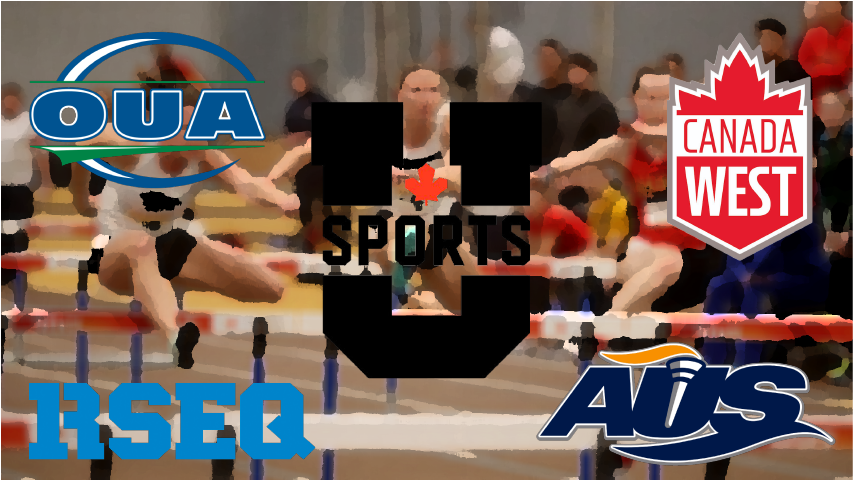
What does it mean to receive a Canadian “full-ride” scholarship?
In the Canadian system, a full-ride scholarship means that your tuition fees will be fully paid for. Anything billed by the university, such as textbooks, will be covered too. Tuition plus mandatory fees is the maximum coverage a student can receive in Canada; housing and other living expenses cannot be paid for. While these are the rules set out by the Canadian system, each province and each individual institutions can impose even stricter guidelines. As well each individual university has their own rules and the right to reserve how much funding is available and can be given to their athletes.
A good example of this is the province of Ontario. Universities in Ontario are restricted to offering a maximum AFA of $4,500 per year ($5,000 per year beginning in 2023/2024). This means that a "full-ride" in Ontario may not necessarily cover full tuition and mandatory expenses. Further still, a university within Ontario may not give this much scholarship money out to their athletes, whether by choice or because the funds just don’t exist at their program. Just because schools are allowed to give out a certain amount of prize money, doesn’t mean they can or that they will.
Partial scholarships (any denomination other than a “full-ride”) can range from under a thousand dollars up to the total cost of tuition and mandatory university fees. According to MacLean’s, tuition in most provinces is over $5,000 a year, the average Canadian sports scholarship is $1,060.
If your university fees cost $5,500 a year and you were to receive a full scholarship, this fee would be covered. But, a partial scholarship of say, $2,000 a year, would leave you to pay the outstanding $3,500.
Where does the money come from?
The scholarships offered in Canada are fully reliant on funding, which every university receives in different ways. Some universities provide scholarships through their operating budgets, there may be donors that hand out scholarships as they please, and alumni may even donate to a portion of the funding.
It’s also important to note that it’s common for athletes to ask coaches how much the program has to offer and what types of different scholarships are available. The value of a scholarship for any particular prospective student-athlete may vary from institution to institution, depending on budget, athletic performance, and other factors the coach considers.
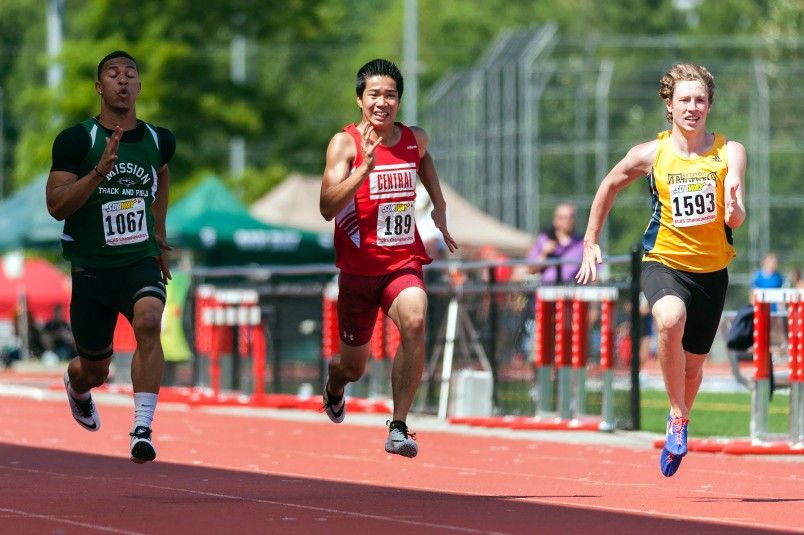
Am I eligible for a Canadian U SPORTS scholarship?
For U SPORTS student-athletes entering their first year of university, they must maintain a minimum grade point average of 80% out of high school to qualify for prize money. If an athlete is unable to do so, they may be able to gain an athletic scholarship at the end of their first year if they acquire a 65% average or higher. Similarly, maintaining scholarship eligibility once in university is dependent on a 65% average at the beginning of each year. In Ontario, this magic number is slightly higher at 70%. Additionally, athletic performance is also a key factor that contributes to the amount of the scholarship money an athlete can receive. Generally, the faster the time, the greater the jump, or further the throw can result in a larger scholarship for you, but it is important to contact coaches and universities you are interested in to see how much you can be offered in their specific program.
At Streamline Athletes, we work closely with coaches at universities to understand their team’s individual requirements for walk-on roster spots and for scholarship consideration. We help student-athletes and their families who are looking for track and field scholarships by delivering transparent information on the university track and field landscape all in one place.
Athletic scholarships in the United States
Many Canadian and international athletes elect to study, train, and compete in the American collegiate system. Understanding how American associations like the NCAA, NAIA, and NJCAA differ from Canada’s U SPORTS is vital in making your university decision.
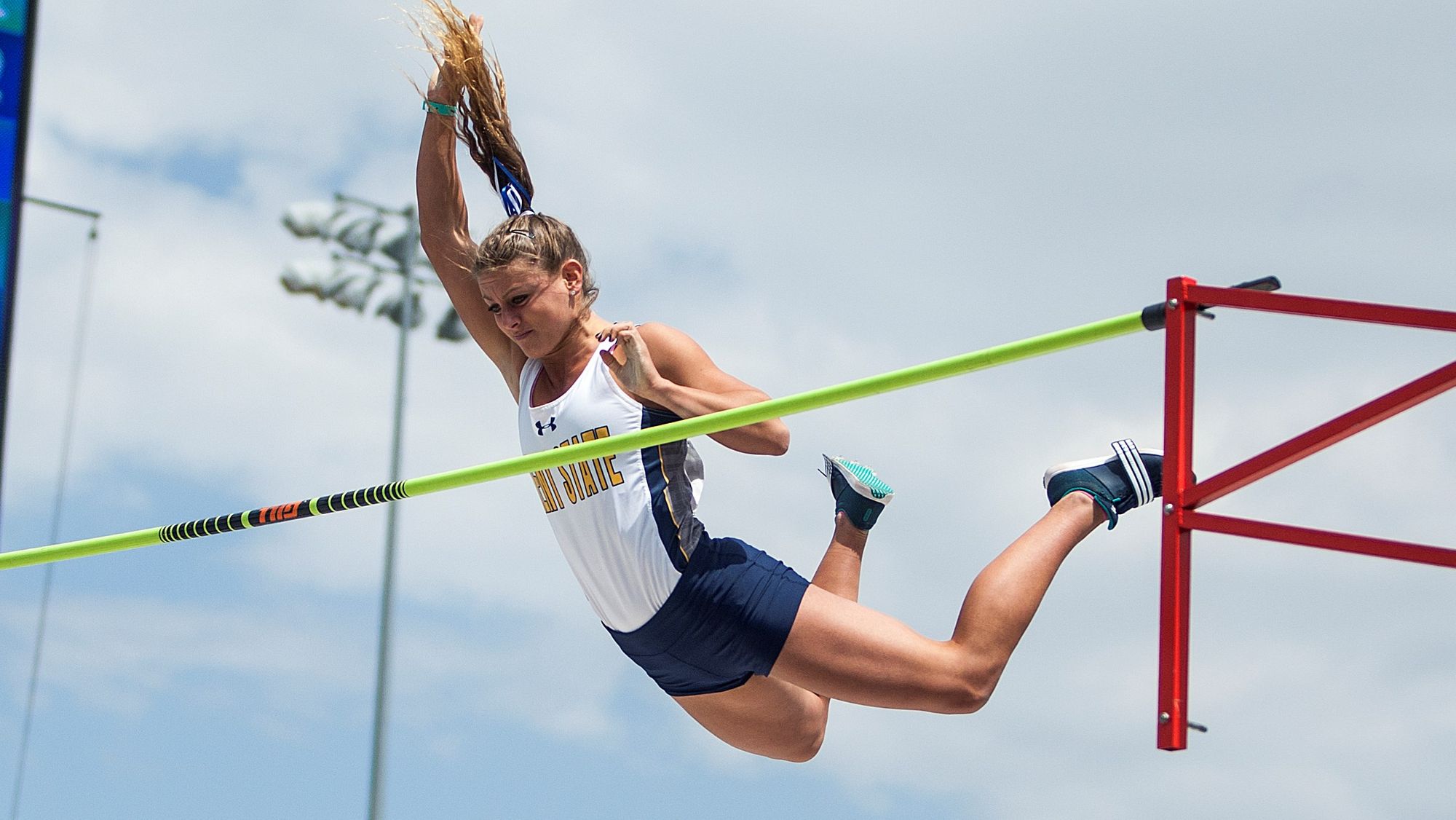
While it may be true that American programs have the potential to give out significantly more scholarship money to individual student-athletes than Canadian schools, that doesn’t mean that the States is always a better financial option. This is because tuition at US schools tends to range from $25,000 to $40,000 US per year for international students, while in Canada, tuition is in the $5,000 to $6,000 CAD range.
A $2,000 CAD scholarship in Canada could cover close to half of the cost of tuition and mandatory fees, while at least 10 times this much would be required for the student-athlete to incur the same personal cost below the border.
My point here: there is potential for big money in the States, but it’s important to do the math and understand the implications of scholarship dollars versus total annual cost no matter where your options are.
What is classified as a “full-ride” in the United States?
Known as an “inclusive scholarship”, NCAA D-I and D-II full-rides virtually pay for everything — tuition is fully covered and so are housing fees, meals, course-related books and supplies, and sometimes even other expenses.
To cover the costs of all these expenses, the largest track and field scholarships in the USA can reach as much as $60,000 a year. If an athlete takes four years to complete their degree and is fortunate enough to renew their scholarship contract each year, their prize money could accumulate to as much as $240,000 throughout their time at university.
But… most athletic scholarships are not full-rides. The majority of student athletes receiving an athletic scholarship will only receive enough money to cover some of the previously mentioned costs. If you’re attending an American school, you may still need to pay $20,000 in tuition fees even in the event you’re awarded $5,000 to $25,000 in scholarship funding from the athletic department
With that being said, there are a variety of different scholarship types that can be earned in addition to an athletic scholarship, including academic and international awards. Always keep in mind that track and field scholarships are not multi-year deals, they are awarded year by year and are dependant on a combination of athletic performance, roster changes, personal situation. A change in athletic scholarship denomination from one year to the next usually comes as a result of a change in situation but the point here is that no award is guaranteed throughout the duration of your degree.
There are over 1,200 universities and colleges in the USA offering track and field programs and they range in performance level. This means there is a place for virtually everyone. The likelihood and amount of scholarship opportunities depends on your skill set and performance, and your academics. Coaches award scholarships in a puzzle, they are often made up of athletic and academic prize money, which is often the case for international students. It is all about finding the right fit for you; you don’t need to be a national champion, or world-ranked athlete to receive a scholarship in the USA.
Why is awarding scholarships so complicated for American programs?
Just like at Canadian institutions, American schools are given scholarship caps by their associations. NAIA and NCAA D-I and D-II track and field teams are allowed a maximum of full-ride scholarships to divvy up how the coaches see fit. And it differs for men and women. Here’s a breakdown:
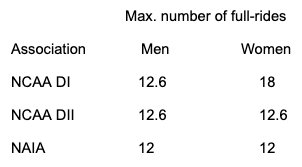
These numbers are for the entire track and field team and have to be spread out amongst throwers, runners of all distances, hurdlers, jumpers... you get the point. Again, it’s important to remember that just because the programs are allowed to offer these denominations of full-rides, it doesn’t mean they are capable or that they will hit their cap.
Maintaining scholarship eligibility in the United States
A student must have a minimum SAT score or ACT sum score to be eligible for an NCAA scholarship. If a student has a minimum 2.0 GPA on a 4.0 scale they must score a combined 1010 on the critical reading and mathematics sections of the SAT to be eligible. Similarly, if a student has a minimum 2.0 GPA they must score a combined total of 86 points on the ACT to be eligible. The ACT sum score is generated from the English, mathematics, reading and science sections of the exam. The NCAA Eligibility Center does not use the writing portion of the SAT or ACT when determining eligibility. However, individual universities may look at all sections of the exams during the university admissions process.
Some schools, such as Ivy League schools in Division I set an even higher academic requirement. Additionally, to compete in your freshman year at a Division I school, you must achieve a minimum 2.3 GPA (that number is 2.2 at Division II schools). For Division III institutions, the schools will set their own admission standards. As well, similar to Canadian Universities, a student-athlete can be offered more scholarship money the better their performances are on the track or field. It is just up to the coach to divide the scholarship money between the athletes on the team.
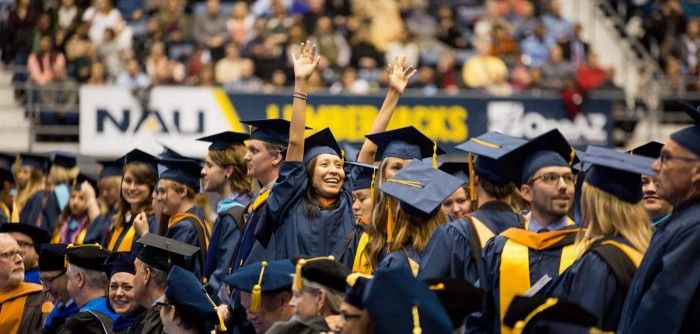
A Couple More Tidbits!
What if I don’t get an athletic scholarship?
Not to worry! Universities offer a number of other awards to incoming students, such as academic success scholarships, citizen scholarships and international scholarships. Be sure to explore the websites of the universities you are interested in to discover other financial aid and scholarship options.
Can my athletic scholarship be taken away?
While there is a possibility of this happening make sure you understand the terms of your scholarship contract so you are not taken by surprise is this happens.
How will my athletic scholarship get taken away?
As stated by the NCAA:
Aid based in any degree on athletics ability cannot be awarded in excess of one academic year; the decision of whether a student-athlete is awarded institutional financial aid is made on a year-by-year or term-by-term basis, depending on the regulations of the institution. If a student-athlete is receiving institutional financial aid based in any degree on athletics ability, that financial aid MAY be reduced or canceled during the period of award (e.g., during that year or term) only if the student-athlete:
- Renders himself or herself eligible for intercollegiate competition
- Misrepresents any information on an application, letter of intent or financial aid agreement
- Commits serious misconduct
- Voluntarily quits the sport
One season you may have an athletic scholarship, the next you may not. The university you attend is under no obligation to renew your athletic scholarship, since scholarships are based on a yearly contract. Your future coach is free to renew or pull your scholarship.
As a student athlete you need to maintain certain academic standards to be eligible for prize money (previously mentioned). As well, if you become injured outside of university you may also lose your scholarship. Partaking in risky behaviour such as rock climbing may result in receiving an injury outside of practice and therefore an unhappy coach. Dependent on how severe the injury is, the consequence could be the loss of a scholarship.
This being said there is also the possibility of your scholarship increasing if you perform well! Keep up the grind. It will pay off!
Start your scholarship search today!
Receiving an athletic scholarship can make the transition to university that much easier! Start your research on schools to see what is available to you. If you aren’t quite sure what universities will be able to provide you with funding and where you fit athletically not to worry! You can research collegiate track and field/cross-country programs now on Streamline Athletes. Start your conversations with coaches and see what they and their institution have to offer you!
Processing your application
There was an error sending the email, please try again

